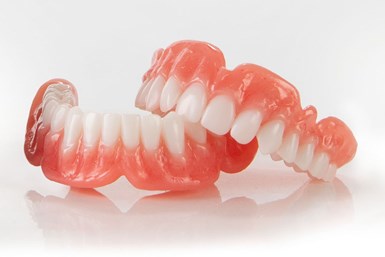Desktop Health Receives FDA Clearance for Flexcera 3D Printed Dentures
Resin technology for dental prosthetics is said to deliver superior strength, aesthetics and function for patients.
Share
Read Next

Flexcera final product
Desktop Health, a Desktop Metal business line focused on developing 3D printing and biofabrication solutions for personalized medicine, has received U.S. Food and Drug Administration (FDA) 510(k) clearance for its Flexcera Base. The resin is designed for use in 3D fabrication of high-quality dental prosthetics and, along with the Flexcera Smile, are Desktop Health’s first formulated and optimized digital dental solutions.
Flexcera is comprised of proprietary resins for the fabrication of natural looking, functional dentures with ceramic-like strength. Flexcera Smile is an FDA Class 1 Medical Device for the fabrication of lifelike denture teeth and Flexcera Base is an FDA Cleared Class 2 Medical Device for the fabrication of premium denture bases. Both are formulated exclusively for use with EnvisionTec 3D printers.
The Flexcera base features a unique long-chain chemistry formulated and optimized for 3D printing. The company says it offers patients a same-day digital denture solution with three times the toughness of competitive denture material and lifelike tooth translucency.
“Three years ago, we set out to create a product that addressed the limitations of current 3D printed dental prosthetics — brittleness and poor aesthetics,” says Michael Jafar, Desktop Health president and CEO. “The introduction of Flexcera marks the inception of a remarkable new era in dentistry, combining advanced Flexcera science with 3D printing technology to deliver superior strength, aesthetics and function for patients.”
When Flexcera is used with EnvisionTec 3D printers, dental providers can print up to eight customized Flexcera dentures in less than two hours, delivering same-day, high quality dental prosthetics.
The Flexcera digital solution is said to offer high fracture resistance, moisture resistance to prevent staining or discoloration, and an overall natural aesthetic that offers lifelike tooth translucency and a natural-looking smile.
Related Content
-
What We Found at Formnext 2023
New metal processes, new possibilities for existing processes, the next step for copper and more. Here is a summary drawing on all our reporting from November’s event.
-
Italian Furniture Maker Uses WASP Technology to Create 3D Printed Pendant Lamps
The versatility of 3D printed ceramic enabled the designers to shape a weave reminiscent of the beehive concept, enhanced by the light source.
-
AM 101: What Is Binder Jetting? (Includes Video)
Binder jetting requires no support structures, is accurate and repeatable, and is said to eliminate dimensional distortion problems common in some high-heat 3D technologies. Here is a look at how binder jetting works and its benefits for additive manufacturing.













